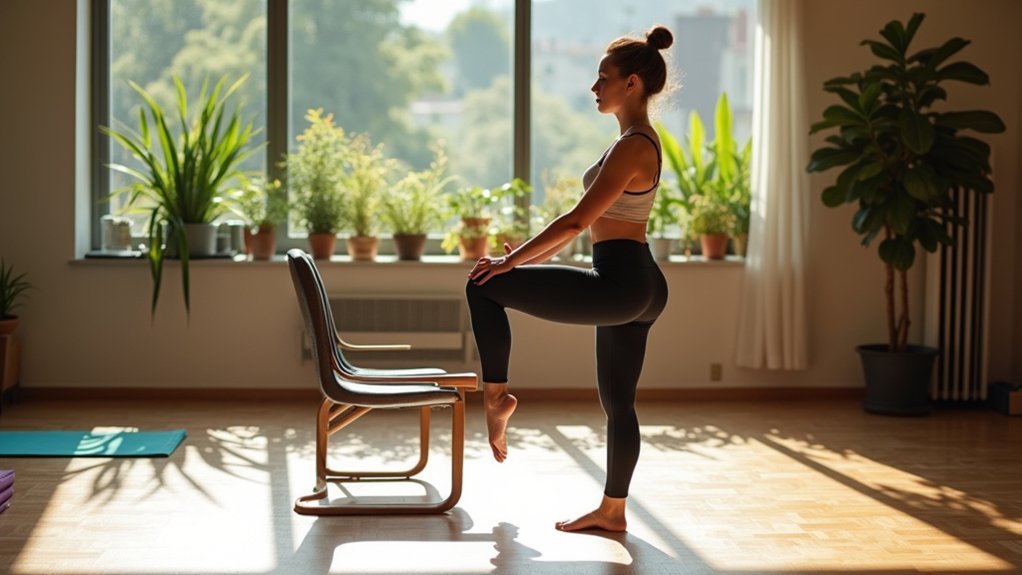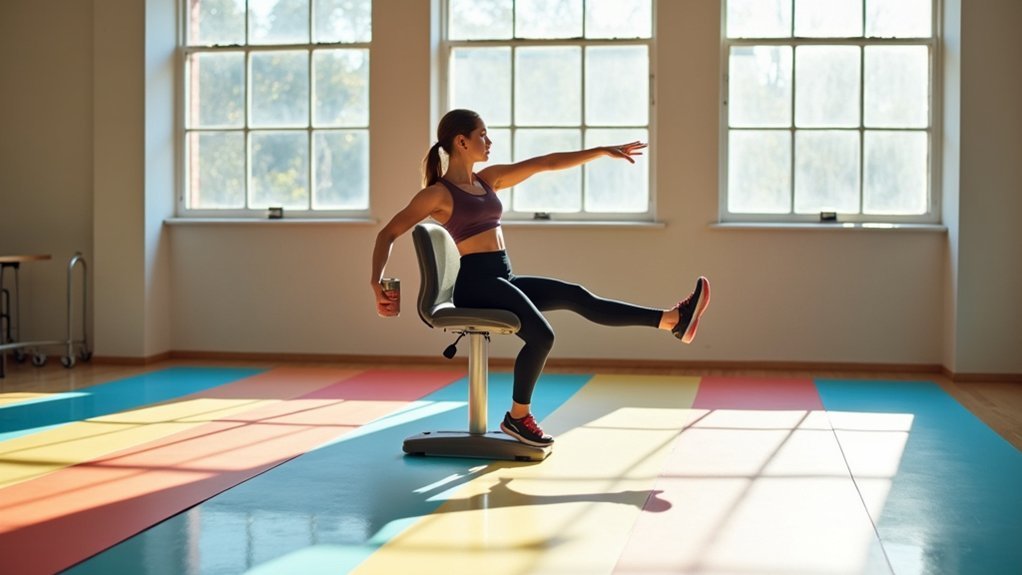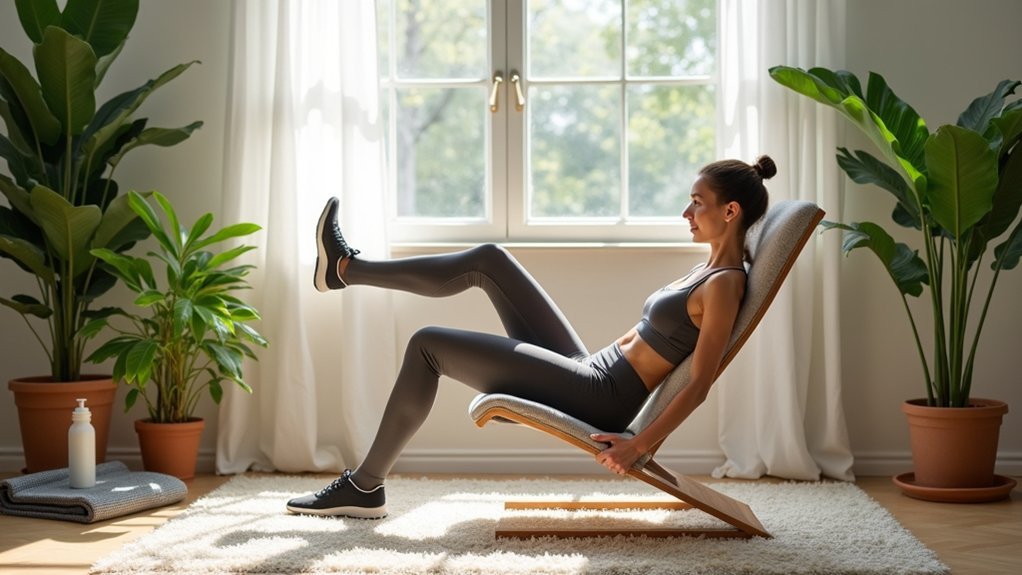Chair exercises offer an accessible way to strengthen your core without straining your joints. You can perform chair crunches, oblique twists, seated bicycle movements, and overhead side leans to target your abs and improve stability. These exercises work well for all fitness levels and require minimal setup—perfect for busy schedules or mobility limitations. Start with 30-second holds and gradually increase intensity as your strength improves. The following guide reveals how to transform simple seated movements into powerful core-building techniques.
Why Chair Exercises Are Ideal for Core Strength Development

While many fitness enthusiasts focus on floor exercises for core training, chair-based movements offer unique advantages that shouldn’t be overlooked. These exercises provide accessibility for all fitness levels with minimal joint strain while still effectively engaging your deep abdominal muscles.
Chair exercises stabilize your spine during everyday movements like sitting and standing, improving posture and reducing back pain. They’re perfect if you have mobility limitations or want to avoid floor positions that stress your knees and hips.
Chair exercises enhance spinal stability during daily activities, providing an accessible alternative that protects joints while promoting better posture.
You’ll likely stick with chair workouts because they require minimal setup, can be done anywhere, and easily fit into your daily routine. The familiar equipment reduces exercise anxiety while promoting mindfulness through controlled movements.
Plus, these exercises strengthen your pelvic floor and improve circulation, combating the effects of sedentary behavior. Regular chair exercises can help counteract how sitting tilts the pelvis backward and negatively affects your spine shape.
Essential Chair Exercises for Abdominal and Oblique Muscles
Whether you’re a fitness beginner or simply prefer low-impact options, chair-based core exercises provide an effective way to strengthen your abdominal and oblique muscles without straining your joints.
These accessible workouts can be performed anywhere and modified to suit your fitness level.
Try these effective chair exercises to target your core:
- Chair Crunch: Sit forward, hands on head, lean back slightly, then crunch forward to engage your abs
- Oblique Twist: Maintain an upright position while twisting your torso side to side
- Seated Bicycle Crunch: With hands behind your head, mimic a pedaling motion to work your obliques
- Overhead Side Lean: Extend arms overhead and lean to each side for a deep stretch
Combining these movements creates a thorough routine that improves posture, stability, and helps reduce back pain.
Adapting Rebounding Movements to Seated Core Workouts

Rebounding exercises—typically performed on mini-trampolines—can be effectively adapted for chair-based workouts, offering similar core benefits without the impact.
Begin with seated sit bounces by maintaining upright posture while performing controlled pelvic tilts that mimic rebounding motions.
For deeper core engagement, try chair-based oblique twists by rotating your torso while keeping your pelvis stable.
Extend your arms parallel to the floor and exhale during rotations to maximize abdominal activation. Add isometric holds mid-rotation for increased muscle tension.
These seated movements activate hip flexors as effectively as rebounding while being more accessible for beginners.
Enhance these movements by incorporating static core contractions and pelvic floor engagement during bounces.
You can progress by adding resistance bands anchored to chair legs or placing a partially deflated stability ball on your seat for increased challenge.
Always maintain proper alignment with ankles below knees and hips below shoulders.
Progressive Chair Exercise Sequences for All Fitness Levels
Creating an effective chair exercise routine requires matching movements to your current fitness capabilities while establishing clear progression paths.
Start with beginner-level core activation exercises like seated marches and pelvic tilts before advancing to intermediate resistance movements.
Your progression strategy should follow these principles:
Progress methodically through chair exercises—master stability before complexity, increase tension before resistance, perfect unilateral movements before combinations.
- Begin with stability-focused exercises before adding movement complexity
- Increase time under tension gradually (30-60 seconds) before adding external resistance
- Incorporate unilateral training before combining arm and leg movements
- Use color-coded resistance bands to systematically increase intensity
As you gain strength, challenge yourself with advanced stability exercises like single-leg extensions and seated bicycle crunches.
Don’t rush progression—mastering proper form at each level guarantees you’ll build functional core strength safely while minimizing injury risk.
Chair exercises are low impact and particularly gentle on joints, making them ideal for seniors or those with mobility limitations.
Integrating Seated Core Training Into Your Daily Routine

The true power of core strengthening emerges when you incorporate these exercises seamlessly into your daily life, rather than treating them as isolated workout sessions.
Start your morning with seated marches or cat-cow variations during breakfast, then integrate chair-based knee lifts and torso rotations throughout your workday.
When making phone calls, practice pelvic tilts or chin tucks. During TV commercial breaks, perform leg extensions or heel taps.
Maintain proper ergonomics by adjusting your chair height, using a lumbar roll, and practicing standing shifts that engage your core.
End your day with gentle spinal waves and diaphragmatic breathing to release tension.
Remember to check your posture every 15 minutes—aligning ribs over hips—to maintain core activation throughout all daily activities.
Frequently Asked Questions
Can Chair Exercises Help Reduce Lower Back Pain?
Yes, chair exercises can help reduce your lower back pain. They improve lumbar mobility, balance muscle activation, and prevent pain escalation through dynamic movements like pelvic tilts and abdominal drawing-in exercises performed regularly.
How Long Before I Notice Improvements in My Core Strength?
You’ll notice improvements in 2-4 weeks with consistent practice. Neural changes occur first, followed by endurance gains. Expect significant strength improvements within 8 weeks if you’re exercising 2-3 times weekly.
Are Chair Exercises Effective for Weight Loss Around the Midsection?
Chair exercises contribute to midsection toning, but won’t spot-reduce fat. You’ll see results when combining them with cardio and healthy eating to create a caloric deficit for overall weight loss.
Can I Do Chair Exercises While Recovering From Surgery?
Yes, you can do chair exercises while recovering from surgery, but you’ll need your doctor’s approval first. Start with gentle movements, monitor for pain, and gradually increase intensity as your recovery progresses.
What Type of Chair Is Best for Core-Strengthening Exercises?
For core-strengthening exercises, you’ll benefit most from a ball chair or sway chair that provides controlled instability, forcing your core muscles to engage continuously. Perch stools work well for alternating between sitting and standing.
In Summary
With these chair exercises, you’ve discovered accessible ways to strengthen your core without complex equipment or floor work. You’ll notice improved posture, stability, and everyday functionality as you continue your seated training routine. Remember, consistency matters more than intensity. Start with just 5-10 minutes daily, and you’ll transform your core strength while making wellness a natural part of your daily life.





Leave a Reply